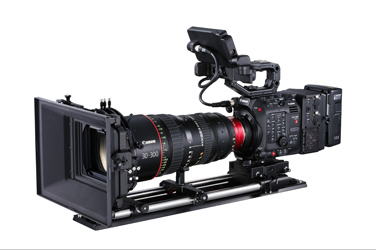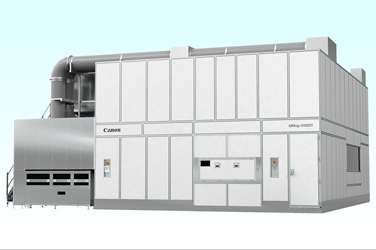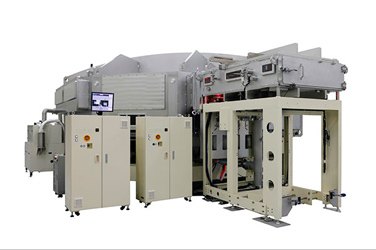Technology in ProductsProfessional reference displays
The Accurate Color Reproduction and Uniform Luminance
that Video Production Professionals Demand
Canon's professional reference displays support video production professionals. The cinema and broadcasting industries are beginning the shift from 4K to 8K, and this shift brings with it greater demands for expressive capabilities. Professional reference displays, as well, are advancing to the next stage, offering not only higher resolutions but also becoming capable of even greater heights of realism through the use of new high-luminance technologies such as HDR.
December 2, 2021

How Displays Work
Different Types of Displays and How They Work
Displays are devices which take input in the form of still image or video signals output from a computer or other device and output it in the form of images or video. There are various types of displays, each with their own distinctive features.
Read More
The Technologies Used in Professional Reference Displays
Unlike ordinary consumer televisions and computer monitors, professional reference displays require a high level of precision with regard to image quality, color uniformity and luminance uniformity.
Canon has developed its own high-quality image processor and backlight to produce displays with high levels of image quality and precision that can leverage the full potential of professional video devices such as digital cinema cameras and broadcast lenses.
They also support state-of-the-art technologies including high dynamic range (HDR), which can depict a wider luminance range than standard dynamic range.
High-quality Image Processor
Canon's image processor, which uses proprietary technologies to achieve high precision computation, offers accurate color reproduction and uniform luminance.

High-quality Image Processor
A Proprietary Engine that Achieves High Image Quality and Precision
One of the most important pieces of equipment on a film or broadcast production site is a reference display, a device used to check the image quality of the content being produced. Having an reference device with image quality that meets the standards for film and broadcasting makes it possible to achieve the same high level of quality, regardless of where in the world the content is being created.
On video production sites that require high precision, reference values must be strictly adhered to. Therefore, image processors must incorporate functionality that include faithful color reproduction, accurate gradations, and high-precision uniformity, and they must be coordinated with the panel and backlight to achieve optimal on-screen correction and highly precise aging correction.
Canon has developed a new image processing engine capable of high-precision processing for its high-resolution 4K and 8K reference displays to ensure the visual expression, quality, and reliability demanded of reference displays. Furthermore, Canon has incorporated its imaging know-how, cultivated over its long history of camera development, into its algorithms to achieve a high level of image quality. Canon is dedicated to quality and performs highly precise adjustments before shipping to ensure that each unit achieves the faithful color reproduction, high-precision uniformity, and long-term consistency expected of the company's reference displays.
Backlight Technology
Backlights that Produce a Wide Color Gamut and High Luminance
Canon's professional reference displays employ a 4K or 8K high-resolution, wide-viewing-angle in-plane-switching (IPS) liquid crystal panel unit that enables the display of high-resolution, high-quality content that meets DCI cinema standards and UHD broadcasting standards.
Canon uses high-purity LEDs for its backlights, thus achieving a wider color gamut. This makes possible faithful reproduction of rich colors that would not be possible on older display models.
What's more, due to recent advances in HDR technology, Canon's professional reference displays were among the first in the video production industry to support HDR standards (HLG: Hybrid Log Gamma, PQ: ST2084). To achieve high luminance and contrast, Canon's displays incorporate more backlight LEDs than conventional standard-dynamic-range (SDR) displays as well as optimized circuit patterns and boards to ensure consistency even at high luminance levels.

HDR Technology
HDR is a technology capable of expressing a wider brightness range than SDR. Thanks to Canon's proprietary image processing engine design and backlight technology, the company's professional reference displays deliver high-definition 4K and 8K images with high luminance and accurate gradations, enabling a level of visual expression in video production not possible with conventional SDR.
For example, the details of clouds in a blue sky, which might have been clipped whites when using SDR, can be clearly seen when using HDR thanks to its improved overall contrast.
In addition, HDR expands not only the range of brightness (luminance) but also the range of colors that can be expressed (color volume). This means that HDR enables reproduction of a wider range of natural colors, making images look more realistic and three-dimensional.
Display firmware also features several HDR monitoring assistance functions, for which Canon was presented an Engineering Excellence Award at the 2018 Hollywood Professional Association (HPA) Awards. Users who create HDR content require functions for quantitatively assessing input signals. The functions of Canon professional reference displays, such as displaying a histogram showing the luminance distribution in graph form, and the false color function, which uses false colors to indicate brightness in an intuitive way, have been met with glowing praise.

color volume

Canon will continue striving to enhance the convenience of HDR workflows and efficiently develop products that support even higher resolutions and luminance.







